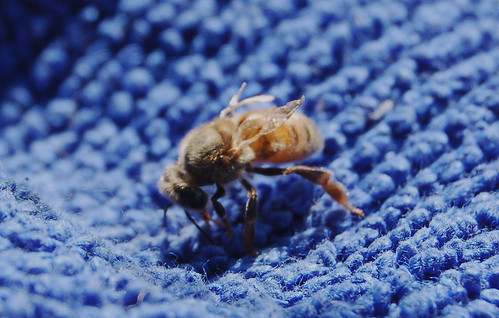Deformed Wing Virus
...

Robb and I were doing a hive inspection today. Mostly, we saw healthy, productive bees, but I did notice a few worrisome things.
This bee almost surely has Deformed Wing Virus. She will clearly never be able to fly, and has probably been evicted from the hive by her sisters. This virus can be an indication of an unhealthy colony of bees. It is often seen in bees with a high load of varroa mites. It is believed that varroa mites put such a burden on the colony's health, that it opens the door to viruses like this one.
Varroa mites are about the size and color of the reddish drips of paint in this photograph. They look like pincher-less crabs, and are a serious parasite of the European Honey Bee.
I think that Robb and I have each seen one single mite since we've had the bees, so we're pretty sure that the bees aren't mite-ridden. Nevertheless, we've placed a mite observation panel under the hive, to monitor "mite fall" for the next forty-eight hours.

Here's another bee with deformed wings. It's a sorry sight. I'm going to do more reading on this subject, and ask the experts on the various beekeeping forums what they think. I'm not sure how worried I should be about this.
Robb and I are committed to the "no medical treatment" approach to the bees. This is considered pretty radical by many people. The idea is that by medicating the bees, beekeepers are "propping up" unhealthy populations, instead of just letting them die, and getting them out of the gene pool.
Part of this approach is being comfortable with a certain amount of illness in any bee colony. We've got tens of thousands of bees, and I've seen three with deformed wings. That's not such a horrible number, when one thinks of the percentages.

This is a bit more mysterious. I think what we're seeing in this photo is an open brood cell with a dead pupal bee inside of it. The larvae are the c-shaped grubs, but what's that above the head of the bee in the middle of the photograph?
The thing is, that there's no way that an immature pupa could open up its own cell. Only when they have metamorphosed into actual bees, can they chew their way out of their brood cell.
Perhaps what we're seeing here is what's known as "hygienic behavior." Perhaps the bees sensed that there was something amiss inside of this cell, and they've opened it up, and are in the process of getting rid of the pupa.
Or perhaps I'm totally misinterpreting what I'm seeing.

Robb and I were doing a hive inspection today. Mostly, we saw healthy, productive bees, but I did notice a few worrisome things.
This bee almost surely has Deformed Wing Virus. She will clearly never be able to fly, and has probably been evicted from the hive by her sisters. This virus can be an indication of an unhealthy colony of bees. It is often seen in bees with a high load of varroa mites. It is believed that varroa mites put such a burden on the colony's health, that it opens the door to viruses like this one.
Varroa mites are about the size and color of the reddish drips of paint in this photograph. They look like pincher-less crabs, and are a serious parasite of the European Honey Bee.
I think that Robb and I have each seen one single mite since we've had the bees, so we're pretty sure that the bees aren't mite-ridden. Nevertheless, we've placed a mite observation panel under the hive, to monitor "mite fall" for the next forty-eight hours.

Here's another bee with deformed wings. It's a sorry sight. I'm going to do more reading on this subject, and ask the experts on the various beekeeping forums what they think. I'm not sure how worried I should be about this.
Robb and I are committed to the "no medical treatment" approach to the bees. This is considered pretty radical by many people. The idea is that by medicating the bees, beekeepers are "propping up" unhealthy populations, instead of just letting them die, and getting them out of the gene pool.
Part of this approach is being comfortable with a certain amount of illness in any bee colony. We've got tens of thousands of bees, and I've seen three with deformed wings. That's not such a horrible number, when one thinks of the percentages.

This is a bit more mysterious. I think what we're seeing in this photo is an open brood cell with a dead pupal bee inside of it. The larvae are the c-shaped grubs, but what's that above the head of the bee in the middle of the photograph?
The thing is, that there's no way that an immature pupa could open up its own cell. Only when they have metamorphosed into actual bees, can they chew their way out of their brood cell.
Perhaps what we're seeing here is what's known as "hygienic behavior." Perhaps the bees sensed that there was something amiss inside of this cell, and they've opened it up, and are in the process of getting rid of the pupa.
Or perhaps I'm totally misinterpreting what I'm seeing.

Comments
Love,
Candace